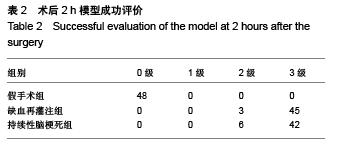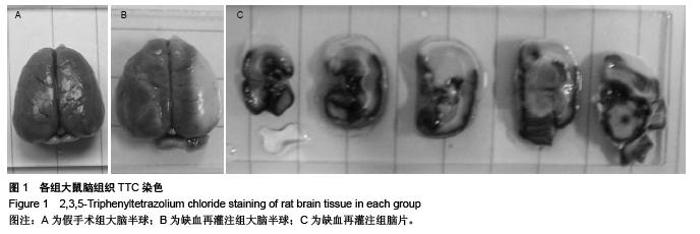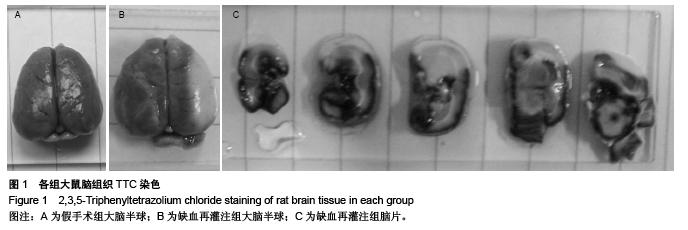Chinese Journal of Tissue Engineering Research ›› 2015, Vol. 19 ›› Issue (49): 7969-7975.doi: 10.3969/j.issn.2095-4344.2015.49.017
Previous Articles Next Articles
Matrix-metalloproteinase-9 expression in focal cerebral infarction models experiencing hemorrhagic transformation
Xiao Jie1, Li Xiao-gang2
- 1Department of Neurology, Yuncheng Municipal Central Hospital, Yuncheng 044000, Shanxi Province, China; 2Department of Neurology, Hospital Affiliated to Luzhou Medical College, Luzhou 046000, Sichuan Province, China
-
Received:2015-09-02Online:2015-11-30Published:2015-11-30 -
Contact:Li Xiao-gang, Chief physician, Professor, Department of Neurology, Hospital Affiliated to Luzhou Medical College, Luzhou 046000, Sichuan Province, China -
About author:Xiao Jie, Master, Department of Neurology, Yuncheng Municipal Central Hospital, Yuncheng 044000, Shanxi Province, China
CLC Number:
Cite this article
Xiao Jie, Li Xiao-gang. Matrix-metalloproteinase-9 expression in focal cerebral infarction models experiencing hemorrhagic transformation [J]. Chinese Journal of Tissue Engineering Research, 2015, 19(49): 7969-7975.
share this article
| [1] Tissue plasminogen activator for acute ischemic stroke. The National Institute of Neurological Disorders and Stroke rt-PA Stroke Study Group.N Engl J Med. 1995;333(24): 1581-1587. [2] Babikian VL, Kase CS, Pessin MS,et al. Intracerebral hemorrhage in stroke patients anticoagulated with heparin. Stroke. 1989;20(11):1500-1503. [3] Rosenberg GA.Matrix metalloproteinases in brain injury.J Neurotrauma. 1995;12(5):833-842. [4] Rosenberg GA. Matrix metalloproteinases in neuroinflammation. Glia. 2002;39(3):279-291. [5] 李国忠,尹燕红,王德生.出血性转化的研究进展[J].国外医学:脑血管疾病分册,2004,12(12):907-910. [6] 盛文利,黄如训.重视脑梗死的出血性转化[J].中国神经精神疾病杂志,2012,38(2): 126-128. [7] Romanic AM, White RF, Arleth AJ, et al. Matrix metalloproteinase expression increases after cerebral focal ischemia in rats: inhibition of matrix metalloproteinase-9 reduces infarct size.Stroke. 1998;29(5):1020-1030. [8] Lu A, Clark JF, Broderick JP,et al. Reperfusion activates metalloproteinases that contribute to neurovascular injury.Exp Neurol. 2008;210(2):549-559. [9] Kuluz JW, Gregory GA, Han Y, et al. Fructose-1, 6-bisphosphate reduces infarct volume after reversible middle cerebral artery occlusion in rats.Stroke.1993;24(10): 1576-1583. [10] 王伟.严格控制实验条件,建立标准化脑缺血动物模型[J].中华神经科杂志,1998,31(5):261-263. [11] 卜碧涛,王伟,张苏明.大鼠脑缺血模型制作过程中麻醉方法的选择与应用[J].同济医科大学学报,1998,27(3):202-205. [12] Koizumi J,Yoshida Y,Nakazawa T.Experimental studies of ischemic brain edema:1.A new experimental model of cerebral embolism in rats in which recirculation can be introduced in the ischemic area. Jan J Stroke.1986; 8(5): 1-8. [13] Longa EZ, Weinstein PR, Carlson S,et al.Reversible middle cerebral artery occlusion without craniectomy in rats.Stroke. 1989;20(1):84-91. [14] Minematsu K, Li L, Fisher M, et al.Diffusion-weighted magnetic resonance imaging: rapid and quantitative detection of focal brain ischemia.Neurology. 1992;42(1):235-240. [15] Nagasawa H, Kogure K.Correlation between cerebral blood flow and histologic changes in a new rat model of middle cerebral artery occlusion.Stroke. 1989;20(8): 1037-1043. [16] Kuge Y, Minematsu K, Yamaguchi T,et al. Nylon monofilament for intraluminal middle cerebral artery occlusion in rats.Stroke. 1995;26(9):1655-1657. [17] Markgraf CG, Velayo NL, Johnson MP,et al.Six-hour window of opportunity for calpain inhibition in focal cerebral ischemia in rats.Stroke. 1998;29(1):152-158. [18] Young AR, Touzani O, Derlon JM,et al.Early reperfusion in the anesthetized baboon reduces brain damage following middle cerebral artery occlusion: a quantitative analysis of infarction volume.Stroke. 1997;28(3):632-637. [19] Nishimura MC, Davis RL, Bartkowski H.Rat middle cerebral artery occlusion: evaluation of the model and development of a neurologic examination.Stroke. 1986; 17(3):472-476. [20] Bederson JB, Pitts LH, Germano SM, et al.Evaluation of 2,3,5-triphenyltetrazolium chloride as a stain for detection and quantification of experimental cerebral infarction in rats.Stroke. 1986;17(6):1304-1308. [21] Garcia JH, Wagner S, Liu KF,et al. Neurological deficit and extent of neuronal necrosis attributable to middle cerebral artery occlusion in rats. Statistical validation.Stroke. 1995; 26(4):627-634. [22] Persson L, Hårdemark HG, Bolander HG,et al.Neurologic and neuropathologic outcome after middle cerebral artery occlusion in rats.Stroke. 1989;20(5):641-645. [23] Germano IM, Bartkowski HM, Cassel ME,et al.The therapeutic value of nimodipine in experimental focal cerebral ischemia. Neurological outcome and histopathological findings. J Neurosurg. 1987;67(1):81-87. [24] Nagasawa H, Kogure K.Correlation between cerebral blood flow and histologic changes in a new rat model of middle cerebral artery occlusion.Stroke. 1989;20(8): 1037-1043. [25] Millikan C.Animal stroke models.Stroke. 1992;23(6): 795-797. [26] Bederson JB, Pitts LH, Tsuji M,et al.Rat middle cerebral artery occlusion: evaluation of the model and development of a neurologic examination.Stroke. 1986;17(3):472-476. [27] Ginsberg MD.The validity of rodent brain-ischemia models is self-evident.Arch Neurol. 1996;53(10):1065-1067. [28] Petty MA, Wettstein JG.Elements of cerebral microvascular ischaemia.Brain Res Brain Res Rev. 2001; 36(1):23-34. [29] Fujimura M, Gasche Y, Morita-Fujimura Y,et al.Early appearance of activated matrix metalloproteinase-9 and blood-brain barrier disruption in mice after focal cerebral ischemia and reperfusion.Brain Res.1999;842(1):92-100. [30] Romanic AM, White RF, Arleth AJ,et al.Matrix metalloproteinase expression increases after cerebral focal ischemia in rats: inhibition of matrix metalloproteinase-9 reduces infarct size.Stroke. 1998; 29(5):1020-1030. [31] Rosenberg GA.Growth and bleeding in BAVM: another role for MMPs.Stroke. 2003;34(4):925-931. [32] Colton CA, Keri JE, Chen WT,et al.Protease production by cultured microglia: substrate gel analysis and immobilized matrix degradation.J Neurosci Res. 1993;35(3):297-304. [33] 许宏伟,杨期东,刘晓英,等.MMP-2/9与脑出血后脑水肿的关系探讨[J].中风与神经疾病杂志,2004,21(4):295-297. [34] Hou HL, Zhang HG, Gong HL, et al. High matrix metalloproteinase-9 expression induces angiogenesis and basement membrane degradation in stroke-prone spontaneously hypertensive rats after cerebral infarction. Neural Regen Res. 2014;9 (11): 1154-1162 [35] Heo JH, Lucero J, Abumiya T,et al.Matrix metalloproteinases increase very early during experimental focal cerebral ischemia.J Cereb Blood Flow Metab. 1999;19(6):624-633. [36] Lapchak PA, Chapman DF, Nunez SY,et al. Dehydroepiandrosterone sulfate is neuroprotective in a reversible spinal cord ischemia model: possible involvement of GABA(A) receptors.Stroke. 2000;31(8):1953-1956. [37] Choi ET, Collins ET, Marine LA,et al. Matrix metalloproteinase-9 modulation by resident arterial cells is responsible for injury-induced accelerated atherosclerotic plaque development in apolipoprotein E-deficient mice.Arterioscler Thromb Vasc Biol. 2005;25(5): 1020-1025. [38] Matter K, Balda MS.Functional analysis of tight junctions. Methods. 2003;30(3):228-234. [39] Asahi M, Wang X, Mori T,et al. Effects of matrix metalloproteinase-9 gene knock-out on the proteolysis of blood-brain barrier and white matter components after cerebral ischemia.J Neurosci. 2001;21(19):7724-7732. [40] Rosell A, Cuadrado E, Ortega-Aznar A, et al. MMP-9-positive neutrophil infiltration is associated to blood-brain barrier breakdown and basal lamina type IV collagen degradation during hemorrhagic transformation after human ischemic stroke.Stroke. 2008;39(4):1121-1126. [41] Kim GW, Gasche Y, Grzeschik S,et al. Neurodegeneration in striatum induced by the mitochondrial toxin 3-nitropropionic acid: role of matrix metalloproteinase-9 in early blood-brain barrier disruption.J Neurosci. 2003; 23(25): 8733-8742. [42] Gursoy-Ozdemir Y, Qiu J, Matsuoka N,et al.Cortical spreading depression activates and upregulates MMP-9.J Clin Invest. 2004;113(10):1447-1455. |
| [1] | Chen Ziyang, Pu Rui, Deng Shuang, Yuan Lingyan. Regulatory effect of exosomes on exercise-mediated insulin resistance diseases [J]. Chinese Journal of Tissue Engineering Research, 2021, 25(25): 4089-4094. |
| [2] | Chen Yang, Huang Denggao, Gao Yuanhui, Wang Shunlan, Cao Hui, Zheng Linlin, He Haowei, Luo Siqin, Xiao Jingchuan, Zhang Yingai, Zhang Shufang. Low-intensity pulsed ultrasound promotes the proliferation and adhesion of human adipose-derived mesenchymal stem cells [J]. Chinese Journal of Tissue Engineering Research, 2021, 25(25): 3949-3955. |
| [3] | Yang Junhui, Luo Jinli, Yuan Xiaoping. Effects of human growth hormone on proliferation and osteogenic differentiation of human periodontal ligament stem cells [J]. Chinese Journal of Tissue Engineering Research, 2021, 25(25): 3956-3961. |
| [4] | Sun Jianwei, Yang Xinming, Zhang Ying. Effect of montelukast combined with bone marrow mesenchymal stem cell transplantation on spinal cord injury in rat models [J]. Chinese Journal of Tissue Engineering Research, 2021, 25(25): 3962-3969. |
| [5] | Gao Shan, Huang Dongjing, Hong Haiman, Jia Jingqiao, Meng Fei. Comparison on the curative effect of human placenta-derived mesenchymal stem cells and induced islet-like cells in gestational diabetes mellitus rats [J]. Chinese Journal of Tissue Engineering Research, 2021, 25(25): 3981-3987. |
| [6] | Hao Xiaona, Zhang Yingjie, Li Yuyun, Xu Tao. Bone marrow mesenchymal stem cells overexpressing prolyl oligopeptidase on the repair of liver fibrosis in rat models [J]. Chinese Journal of Tissue Engineering Research, 2021, 25(25): 3988-3993. |
| [7] | Liu Jianyou, Jia Zhongwei, Niu Jiawei, Cao Xinjie, Zhang Dong, Wei Jie. A new method for measuring the anteversion angle of the femoral neck by constructing the three-dimensional digital model of the femur [J]. Chinese Journal of Tissue Engineering Research, 2021, 25(24): 3779-3783. |
| [8] | Meng Lingjie, Qian Hui, Sheng Xiaolei, Lu Jianfeng, Huang Jianping, Qi Liangang, Liu Zongbao. Application of three-dimensional printing technology combined with bone cement in minimally invasive treatment of the collapsed Sanders III type of calcaneal fractures [J]. Chinese Journal of Tissue Engineering Research, 2021, 25(24): 3784-3789. |
| [9] | Qian Xuankun, Huang Hefei, Wu Chengcong, Liu Keting, Ou Hua, Zhang Jinpeng, Ren Jing, Wan Jianshan. Computer-assisted navigation combined with minimally invasive transforaminal lumbar interbody fusion for lumbar spondylolisthesis [J]. Chinese Journal of Tissue Engineering Research, 2021, 25(24): 3790-3795. |
| [10] | Hu Jing, Xiang Yang, Ye Chuan, Han Ziji. Three-dimensional printing assisted screw placement and freehand pedicle screw fixation in the treatment of thoracolumbar fractures: 1-year follow-up [J]. Chinese Journal of Tissue Engineering Research, 2021, 25(24): 3804-3809. |
| [11] | Shu Qihang, Liao Yijia, Xue Jingbo, Yan Yiguo, Wang Cheng. Three-dimensional finite element analysis of a new three-dimensional printed porous fusion cage for cervical vertebra [J]. Chinese Journal of Tissue Engineering Research, 2021, 25(24): 3810-3815. |
| [12] | Wang Yihan, Li Yang, Zhang Ling, Zhang Rui, Xu Ruida, Han Xiaofeng, Cheng Guangqi, Wang Weil. Application of three-dimensional visualization technology for digital orthopedics in the reduction and fixation of intertrochanteric fracture [J]. Chinese Journal of Tissue Engineering Research, 2021, 25(24): 3816-3820. |
| [13] | Sun Maji, Wang Qiuan, Zhang Xingchen, Guo Chong, Yuan Feng, Guo Kaijin. Development and biomechanical analysis of a new anterior cervical pedicle screw fixation system [J]. Chinese Journal of Tissue Engineering Research, 2021, 25(24): 3821-3825. |
| [14] | Lin Wang, Wang Yingying, Guo Weizhong, Yuan Cuihua, Xu Shenggui, Zhang Shenshen, Lin Chengshou. Adopting expanded lateral approach to enhance the mechanical stability and knee function for treating posterolateral column fracture of tibial plateau [J]. Chinese Journal of Tissue Engineering Research, 2021, 25(24): 3826-3827. |
| [15] | Zhu Yun, Chen Yu, Qiu Hao, Liu Dun, Jin Guorong, Chen Shimou, Weng Zheng. Finite element analysis for treatment of osteoporotic femoral fracture with far cortical locking screw [J]. Chinese Journal of Tissue Engineering Research, 2021, 25(24): 3832-3837. |
| Viewed | ||||||
|
Full text |
|
|||||
|
Abstract |
|
|||||







